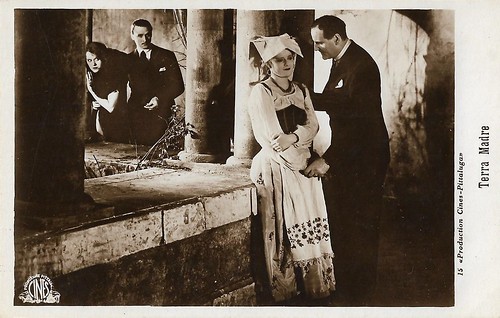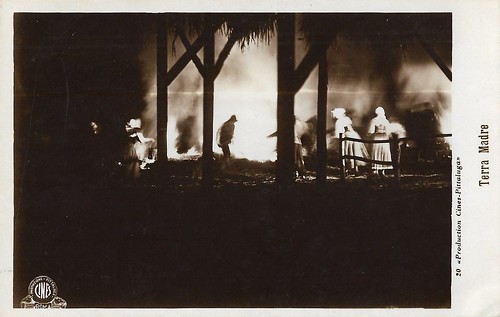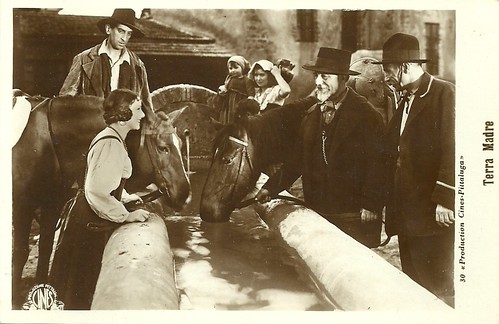Terra madre/Mother Earth (Alessandro Blasetti, 1931), is an Italian early sound film starring Leda Gloria, Sandro Salvini, and Isa Pola. The rural drama was produced by Cines-Pittaluga. The photography of the film shows a great expressive value in chiaroscuro and depth, as can be seen on the postcards, published by G.B. Falci.

Italian postcard by G.B. Falci, Milano, no. 14. Photo: Cines-Pittaluga, Roma. Sandro Salvini in Terra madre/Mother Earth (Alessandro Blasetti, 1931). Here in the middle, Duke Marco (Salvini) quarrels with another man, who is difficult to recognise. he could be Vasco Creti, who plays the foreman and father of Emilia.

Italian postcard by G.B. Falci, Milano, no. 15. Photo: Cines-Pittaluga, Roma. Leda Gloria and Sandro Salvini in Terra madre/Mother Earth (Alessandro Blasetti, 1931). On the right Gloria as Emilia and Salvini as Duke Marco. Left in the back, Isa Pola as Daisy and her friend, played by Giorgio Bianchi.
Sandro Salvini plays Duke Marco, who has been living in the city for a long time, far from the lands he owns. He only returns when he decides to sell them to maintain a costly standard of living which also includes his mistress Daisy (Isa Pola).
His return is welcomed by peasants hoping he'll stay with them. During a solitary tour of his lands, in which he remembers his youth in the countryside with growing nostalgia, Marco meets Emilia (Leda Gloria), the farmer's daughter, and is struck by her spontaneous energy and freshness. When the peasants learn about the news of the sale their enthusiasm turns into disappointment, but Marco, pressured by financial needs, returns to the city with Daisy to sign the documents.
Here he is joined by a phone call from Emilia informing him of a serious fire that broke out on the farm. At that point, Marco leaves everything, runs into the countryside, directs the victorious fight against the fire and decides to revoke the sale. He will stay to take care of his lands and he will marry Emilia.
Terra Madre was drawn from a subject entitled 'Passa la morte', written in 1930 by Camillo Apolloni, a former actor of silent cinema, which was purchased in 1930 by Cines, which was relaunched by Stefano Pittaluga as the first Italian company in the production of sound cinema.
On the basis of this text, Alessandro Blasetti, in collaboration with the writer and silent film director Gianni Bistolfi, wrote the script with the intention of providing "an indication of the social and lyrical value of rural life". Two parties contested the originality of the story, but years after, Blasetti claimed that from the original story "only the boots of the farmer" had remained.

Italian postcard by G.B. Falci, Milano, no. 16. Photo: Cines-Pittaluga, Roma. Leda Gloria and Sandro Salvini in Terra madre/Mother Earth (Alessandro Blasetti, 1931).
Alessandro Blasetti was one of the group of critics gathered around the magazine Cinematografo, who vehemently criticised Pittaluga for years. In 1930, Blasetti and some of his collaborators entered the Cines and became its staunch defenders. The Roman director thus had the opportunity, after the searing failure of Sole (1929) to resume the themes of 'rebirth' at his new studio Cines-Pittaluga.
He did this first with Resurrectio (1931) and then with Terra Madre (1931), in which he revived the 'ruralist' spirit already present in his debut film Sole. It was the contrast between the urban world, considered indolent and parasitic (the 'Stracittà'), and the peasant one (the 'Strapaese'), seen as strong and healthy by a current of fascism, the one born in the countryside, favourable to the preservation of the rural character of the Italian people. Along with Blasetti's other early films, Terra Madre also shows a strong influence of Soviet-style realism.
The film - one of the 10 feature films issued by Cines-Pittaluga in the 1930-1931 season - was shot at theatre 3 of the Cines in Via Vejo in Rome, between September 1930 and January 1931. Locations in the Roman countryside were used for the exteriors. Like the first sound film released in Italy, Gennaro Righelli's La canzone dell'amore, Terra Madre was a co-production of which a German version was made, again at the Cines, on behalf of the company Atlas of Berlin. Kennst Du das Land (1931) was interpreted in the two main roles by Hans Adalbert Schlettow and Maria Solveg (as Maria Matray), and directed by Constantin J. David, who also had directed the German version of the Righelli film.
The future directors Ferdinando Maria Poggioli and Goffredo Alessandrini also worked on the set of Terra Madre. They had entered the Cines as scriptwriter and assistant, both from the group around Cinemagrafo. In early 1931, the magazine had ceased publication when most of its authors were employed by Pittaluga.
Particularly important for highlighting the contrast between city and countryside was the musical comment given on one side to Foxtrot motifs and the other to the rhythm of a popular 'saltarello' and to five choirs performed by the Camerata Lughese of the Canterini Romagnoli. A lot of attention was also paid to photography, so much so that to the two hired operators (Montuori and De Luca) a third assistant joined them, the almost newcomer Clemente Santoni, producing a result of great expressive value in chiaroscuro and depth.
Terra madre was released in March 1931 and was a big success, both critically and commercially. This also was the case for the German version, and equally for a French dubbed version called Le rappel de la terre. Also in Latin America, it was very successful.
Critics were not unanimous in their praise. Some rather praised Pittaluga's effort to raise the new national sound cinema and were less convinced by Blasetti's direction, claiming that in comparison with Sole, in Terra madre the landscape had lost their primitive, raw and pure beauty. Others, such as Leo Longanesi, considered Sole and Terra madre on a par, on equal height. Longanesi called it "a masterpiece of rural rhetoric, an oleograph of our times."

Italian postcard by G.B. Falci, Milano, no. 20. Photo: Cines-Pittaluga, Roma. Publicity still for Terra madre/Mother Earth (Alessandro Blasetti, 1931).

Italian postcard by G.B. Falci, Milano, no. 30. Photo: Cines-Pittaluga, Roma. Leda Gloria in Terra madre/Mother Earth (Alessandro Blasetti, 1931).
Source: Wikipedia (Italian and English) and IMDb.

Italian postcard by G.B. Falci, Milano, no. 14. Photo: Cines-Pittaluga, Roma. Sandro Salvini in Terra madre/Mother Earth (Alessandro Blasetti, 1931). Here in the middle, Duke Marco (Salvini) quarrels with another man, who is difficult to recognise. he could be Vasco Creti, who plays the foreman and father of Emilia.

Italian postcard by G.B. Falci, Milano, no. 15. Photo: Cines-Pittaluga, Roma. Leda Gloria and Sandro Salvini in Terra madre/Mother Earth (Alessandro Blasetti, 1931). On the right Gloria as Emilia and Salvini as Duke Marco. Left in the back, Isa Pola as Daisy and her friend, played by Giorgio Bianchi.
An indication of the social and lyrical value of rural life
Sandro Salvini plays Duke Marco, who has been living in the city for a long time, far from the lands he owns. He only returns when he decides to sell them to maintain a costly standard of living which also includes his mistress Daisy (Isa Pola).
His return is welcomed by peasants hoping he'll stay with them. During a solitary tour of his lands, in which he remembers his youth in the countryside with growing nostalgia, Marco meets Emilia (Leda Gloria), the farmer's daughter, and is struck by her spontaneous energy and freshness. When the peasants learn about the news of the sale their enthusiasm turns into disappointment, but Marco, pressured by financial needs, returns to the city with Daisy to sign the documents.
Here he is joined by a phone call from Emilia informing him of a serious fire that broke out on the farm. At that point, Marco leaves everything, runs into the countryside, directs the victorious fight against the fire and decides to revoke the sale. He will stay to take care of his lands and he will marry Emilia.
Terra Madre was drawn from a subject entitled 'Passa la morte', written in 1930 by Camillo Apolloni, a former actor of silent cinema, which was purchased in 1930 by Cines, which was relaunched by Stefano Pittaluga as the first Italian company in the production of sound cinema.
On the basis of this text, Alessandro Blasetti, in collaboration with the writer and silent film director Gianni Bistolfi, wrote the script with the intention of providing "an indication of the social and lyrical value of rural life". Two parties contested the originality of the story, but years after, Blasetti claimed that from the original story "only the boots of the farmer" had remained.

Italian postcard by G.B. Falci, Milano, no. 16. Photo: Cines-Pittaluga, Roma. Leda Gloria and Sandro Salvini in Terra madre/Mother Earth (Alessandro Blasetti, 1931).
A current of fascism or Soviet-style realism?
Alessandro Blasetti was one of the group of critics gathered around the magazine Cinematografo, who vehemently criticised Pittaluga for years. In 1930, Blasetti and some of his collaborators entered the Cines and became its staunch defenders. The Roman director thus had the opportunity, after the searing failure of Sole (1929) to resume the themes of 'rebirth' at his new studio Cines-Pittaluga.
He did this first with Resurrectio (1931) and then with Terra Madre (1931), in which he revived the 'ruralist' spirit already present in his debut film Sole. It was the contrast between the urban world, considered indolent and parasitic (the 'Stracittà'), and the peasant one (the 'Strapaese'), seen as strong and healthy by a current of fascism, the one born in the countryside, favourable to the preservation of the rural character of the Italian people. Along with Blasetti's other early films, Terra Madre also shows a strong influence of Soviet-style realism.
The film - one of the 10 feature films issued by Cines-Pittaluga in the 1930-1931 season - was shot at theatre 3 of the Cines in Via Vejo in Rome, between September 1930 and January 1931. Locations in the Roman countryside were used for the exteriors. Like the first sound film released in Italy, Gennaro Righelli's La canzone dell'amore, Terra Madre was a co-production of which a German version was made, again at the Cines, on behalf of the company Atlas of Berlin. Kennst Du das Land (1931) was interpreted in the two main roles by Hans Adalbert Schlettow and Maria Solveg (as Maria Matray), and directed by Constantin J. David, who also had directed the German version of the Righelli film.
The future directors Ferdinando Maria Poggioli and Goffredo Alessandrini also worked on the set of Terra Madre. They had entered the Cines as scriptwriter and assistant, both from the group around Cinemagrafo. In early 1931, the magazine had ceased publication when most of its authors were employed by Pittaluga.
Particularly important for highlighting the contrast between city and countryside was the musical comment given on one side to Foxtrot motifs and the other to the rhythm of a popular 'saltarello' and to five choirs performed by the Camerata Lughese of the Canterini Romagnoli. A lot of attention was also paid to photography, so much so that to the two hired operators (Montuori and De Luca) a third assistant joined them, the almost newcomer Clemente Santoni, producing a result of great expressive value in chiaroscuro and depth.
Terra madre was released in March 1931 and was a big success, both critically and commercially. This also was the case for the German version, and equally for a French dubbed version called Le rappel de la terre. Also in Latin America, it was very successful.
Critics were not unanimous in their praise. Some rather praised Pittaluga's effort to raise the new national sound cinema and were less convinced by Blasetti's direction, claiming that in comparison with Sole, in Terra madre the landscape had lost their primitive, raw and pure beauty. Others, such as Leo Longanesi, considered Sole and Terra madre on a par, on equal height. Longanesi called it "a masterpiece of rural rhetoric, an oleograph of our times."

Italian postcard by G.B. Falci, Milano, no. 20. Photo: Cines-Pittaluga, Roma. Publicity still for Terra madre/Mother Earth (Alessandro Blasetti, 1931).

Italian postcard by G.B. Falci, Milano, no. 30. Photo: Cines-Pittaluga, Roma. Leda Gloria in Terra madre/Mother Earth (Alessandro Blasetti, 1931).
Source: Wikipedia (Italian and English) and IMDb.
No comments:
Post a Comment